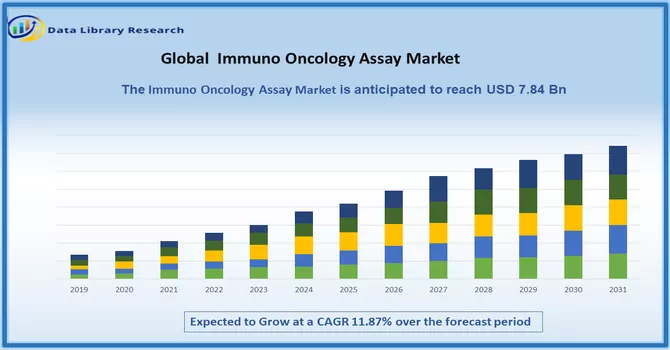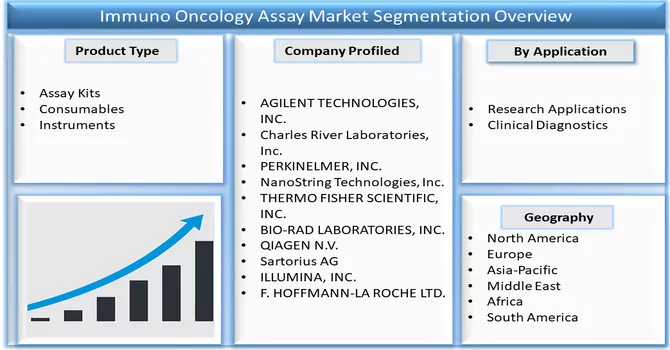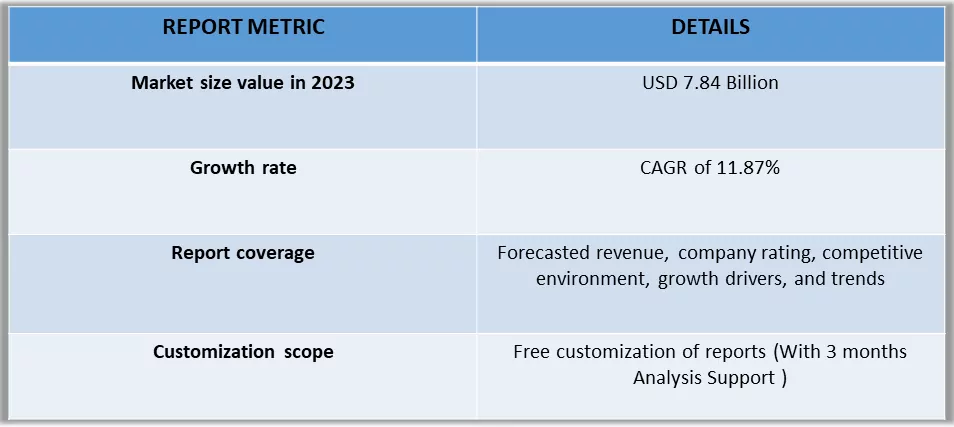The global immuno oncology assays market size was USD 7.84 Billion in 2023 and is predicted to reach at a CAGR of 11.87% during 2024 - 2031.

Get Complete Analysis Of The Report- Download Free Sample PDF
The Immuno-Oncology Assay market plays a pivotal role in the field of cancer research and treatment, offering sophisticated tools and methodologies to assess the immune system's response to cancer cells. This market revolves around cutting-edge assays designed to analyze immune checkpoint proteins, tumor mutational burden, and other immune-related biomarkers. As the demand for personalized cancer therapies grows, immuno-oncology assays provide valuable insights into the intricate interactions between the immune system and cancer cells, driving advancements in cancer immunotherapy.
The market's focus on precision medicine and the quest for more effective cancer treatments underscores its significance in the broader landscape of oncology research and patient care. The robust growth of the Immuno-Oncology Assay market is propelled by several key factors. Firstly, the increasing incidence of cancer worldwide has led to a heightened demand for advanced diagnostic and therapeutic solutions, driving the adoption of immuno-oncology assays. Secondly, the surge in research and development activities in the field of cancer immunotherapy, fueled by growing investments and collaborations, contributes to the expansion of the market. Additionally, the shift towards personalized medicine and the emphasis on identifying predictive biomarkers for immunotherapy response further boost the demand for sophisticated immuno-oncology assays. The convergence of these factors creates a conducive environment for the continuous evolution and market growth of immuno-oncology assays.
Market Segmentation: The global immune oncology assays market is segmented by Product Type (Assay Kits, Consumables and Instruments), Application (Research Applications and Clinical Diagnostics), and Geography (North America, Europe, Asia-Pacific, Latin America, Middle East & Africa). The market size and forecasts are provided in terms of value (in USD million) for all the above segments.

For Detailed Market Segmentation - Download Free Sample PDF
The Immuno-Oncology Assay market is witnessing several notable trends that are shaping its landscape. One prominent trend is the increasing adoption of multiplex assays, allowing simultaneous analysis of multiple biomarkers. This approach provides a comprehensive understanding of the complex interactions within the tumor microenvironment, aiding in more accurate cancer diagnostics and therapeutic decisions.Another significant trend involves the integration of advanced technologies such as Next-generation Sequencing (NGS) and high-throughput screening methods. NGS enables a deeper exploration of the tumor genome, leading to the identification of novel biomarkers and potential therapeutic targets. High-throughput screening facilitates the screening of a large number of compounds against cancer cells, accelerating drug discovery processes in immuno-oncology.Furthermore, there is a growing focus on personalized medicine, tailoring cancer treatments based on the individual patient's immune response profile. Biomarker discovery and companion diagnostics are becoming integral to immuno-oncology research, enabling the development of targeted therapies and immunotherapies that show greater efficacy and reduced adverse effects. The Immuno-Oncology Assay market is also experiencing a surge in collaborations and partnerships between pharmaceutical companies, diagnostic laboratories, and research institutions. This collaborative approach aims to pool resources, share expertise, and expedite the development of innovative assays and technologies, ultimately advancing the field of immuno-oncology.
Market Drivers:
Rising Incidence of Cancer and Increased Focus on Immunotherapy
The growing global incidence of various types of cancers has fueled the demand for advanced diagnostic tools and treatment strategies. Immuno-oncology assays play a crucial role in understanding the complex interactions between the immune system and cancer cells. With a heightened focus on immunotherapy as a promising avenue for cancer treatment, the demand for immuno-oncology assays has surged. These assays help identify biomarkers and assess the immune response, guiding the development of effective immunotherapies and personalized treatment plans.
Advancements in Technology and Biomarker Discovery
Continuous advancements in technology, such as Next-generation Sequencing (NGS), flow cytometry, and multiplex assays, have significantly enhanced the capabilities of immuno-oncology assays. These technologies enable in-depth profiling of the immune system's response to cancer, allowing researchers and clinicians to identify novel biomarkers and therapeutic targets. As the field of biomarker discovery expands, immuno-oncology assays become indispensable tools for characterizing the tumor microenvironment and tailoring treatment strategies, thereby driving their adoption in research, clinical trials, and routine diagnostics.
Market Restraints:
Complexity in Data Interpretation and Standardization Challenges
The intricate nature of immune system interactions with cancer cells presents challenges in interpreting assay results accurately. The complex and dynamic immune responses may lead to variations in data interpretation, making it challenging to establish standardized protocols. The lack of consistent standards across different assays and platforms poses a hurdle in comparing and validating results from various studies. Standardization issues can hinder the seamless integration of immuno-oncology assays into routine clinical practice, limiting their widespread adoption and potentially impacting the reliability of treatment decisions. Addressing these challenges is crucial to enhance the reproducibility and reliability of immuno-oncology assay results, fostering broader acceptance in clinical settings.
The COVID-19 pandemic has significantly influenced the Immuno-Oncology Assay market, presenting a mixed impact characterized by challenges and opportunities. On one hand, the disruptions caused by the pandemic, such as lockdowns, supply chain interruptions, and shifts in healthcare priorities, have led to delays in clinical trials and research activities related to immuno-oncology assays. The focus on addressing urgent healthcare needs and the redirection of resources have affected the pace of assay development and validation.Conversely, the pandemic has underscored the importance of immunotherapy and precision medicine, creating an environment conducive to advancements in immuno-oncology research. The increased emphasis on understanding the immune response and developing targeted therapies has led to renewed interest and investments in immuno-oncology assays. The urgency to enhance diagnostic capabilities and treatment strategies, coupled with the accelerated adoption of digital technologies in healthcare, has facilitated the integration of immuno-oncology assays into broader oncology research and clinical practice.The ongoing efforts to navigate the challenges posed by the pandemic, coupled with the growing recognition of the role of immuno-oncology in personalized cancer treatment, are shaping the market's trajectory. As the healthcare ecosystem adapts to the evolving landscape, the Immuno-Oncology Assay market is poised to play a pivotal role in advancing our understanding of cancer immunotherapy and contributing to improved patient outcomes.

Get Complete Analysis Of The Report- Download Free Sample PDF
The analyzed market exhibits a high degree of fragmentation, primarily attributable to the presence of numerous players operating on both a global and regional scale. The competitive landscape is characterized by a diverse array of companies, each contributing to the overall market dynamics. This fragmentation arises from the existence of specialized solution providers, established industry players, and emerging entrants, all vying for market share. The diversity in market participants is underscored by the adoption of various strategies aimed at expanding the company presence. On a global scale, companies within the studied market are strategically positioning themselves through aggressive expansion initiatives. This often involves entering new geographical regions, targeting untapped markets, and establishing a robust global footprint. The pursuit of global expansion is driven by the recognition of diverse market opportunities and the desire to capitalize on emerging trends and demands across different regions. Simultaneously, at the regional level, companies are tailoring their approaches to align with local market dynamics. Regional players are leveraging their understanding of specific market nuances, regulatory environments, and consumer preferences to gain a competitive edge. This regional focus allows companies to cater to the unique needs of local clientele, fostering stronger market penetration. To navigate the complexities of the fragmented market, companies are implementing a range of strategies. These strategies include investments in research and development to stay at the forefront of technological advancements, mergers and acquisitions to consolidate market share, strategic partnerships for synergies, and innovation to differentiate products and services. The adoption of such multifaceted strategies reflects the competitive nature of the market, with participants continually seeking avenues for growth and sustainability. In essence, the high fragmentation in the studied market not only signifies the diversity of players but also underscores the dynamism and competitiveness that drive ongoing strategic maneuvers. As companies explore various avenues for expansion, the market continues to evolve, presenting both challenges and opportunities for industry stakeholders.
Some of the key market players are:
Recent Development:
1) In January 2024, AbbVie Inc. (NYSE: ABBV) and Tentarix Biotherapeutics announced a collaboration to develop conditionally-active, multi-specific biologic candidates in oncology and immunology. This partnership combines AbbVie's expertise with Tentarix's Tentacles™ platform, potentially leading to the creation of novel biomarkers and immunoassay platforms. These advancements could significantly impact the immunoassay market, offering more accurate and reliable diagnostic tools and improving treatment modalities for patients.
2) In February 2024, Mestag Therapeutics announced the addition of renowned advisors to support the development of its lead program, M300, an antibody program aimed at inducing Tertiary Lymphoid Structures (TLS) in tumors. This development has the potential to impact the immunoassay market significantly by potentially introducing new biomarkers associated with TLS formation, which could enhance the accuracy and specificity of immunoassays used in cancer diagnostics and treatment monitoring. Additionally, insights from M300's development could lead to the creation of novel immunoassay technologies tailored to detect TLS formation, potentially improving cancer patient care and management.
Q1. What was the Immuno Oncology Assay Market size in 2023?
As per Data Library Research the global immuno oncology assays market size was USD 7.84 Billion in 2023.
Q2. At what CAGR is the market projected to grow within the forecast period?
Immuno Oncology Assay Market is predicted to reach at a CAGR of 11.87% during the forecast period.
Q3. What are the factors on which the Immuno Oncology Assay market research is based on?
By Product Type, By Application and Geography are the factors on which the Immuno Oncology Assay market research is based.
Q4. Who are the key players in Immuno Oncology Assay Market?
Some key players operating in the market include
Data Library Research are conducted by industry experts who offer insight on industry structure, market segmentations technology assessment and competitive landscape (CL), and penetration, as well as on emerging trends. Their analysis is based on primary interviews (~ 80%) and secondary research (~ 20%) as well as years of professional expertise in their respective industries. Adding to this, by analysing historical trends and current market positions, our analysts predict where the market will be headed for the next five years. Furthermore, the varying trends of segment & categories geographically presented are also studied and the estimated based on the primary & secondary research.
In this particular report from the supply side Data Library Research has conducted primary surveys (interviews) with the key level executives (VP, CEO’s, Marketing Director, Business Development Manager and SOFT) of the companies that active & prominent as well as the midsized organization
FIGURE 1: DLR RESEARH PROCESS

Extensive primary research was conducted to gain a deeper insight of the market and industry performance. The analysis is based on both primary and secondary research as well as years of professional expertise in the respective industries.
In addition to analysing current and historical trends, our analysts predict where the market is headed over the next five years.
It varies by segment for these categories geographically presented in the list of market tables. Speaking about this particular report we have conducted primary surveys (interviews) with the key level executives (VP, CEO’s, Marketing Director, Business Development Manager and many more) of the major players active in the market.
Secondary ResearchSecondary research was mainly used to collect and identify information useful for the extensive, technical, market-oriented, and Friend’s study of the Global Extra Neutral Alcohol. It was also used to obtain key information about major players, market classification and segmentation according to the industry trends, geographical markets, and developments related to the market and technology perspectives. For this study, analysts have gathered information from various credible sources, such as annual reports, sec filings, journals, white papers, SOFT presentations, and company web sites.
Market Size EstimationBoth, top-down and bottom-up approaches were used to estimate and validate the size of the Global market and to estimate the size of various other dependent submarkets in the overall Extra Neutral Alcohol. The key players in the market were identified through secondary research and their market contributions in the respective geographies were determined through primary and secondary research.
Forecast Model
